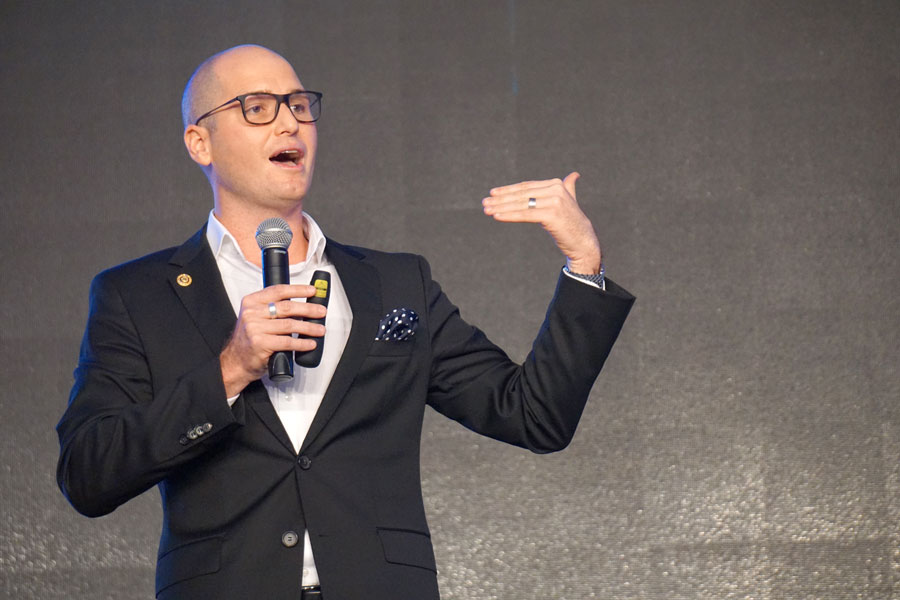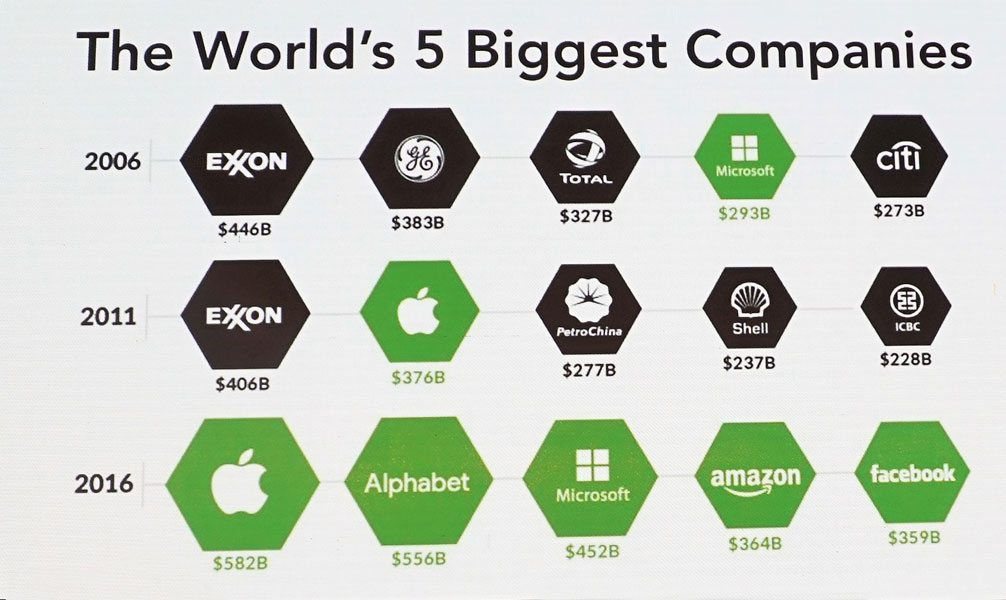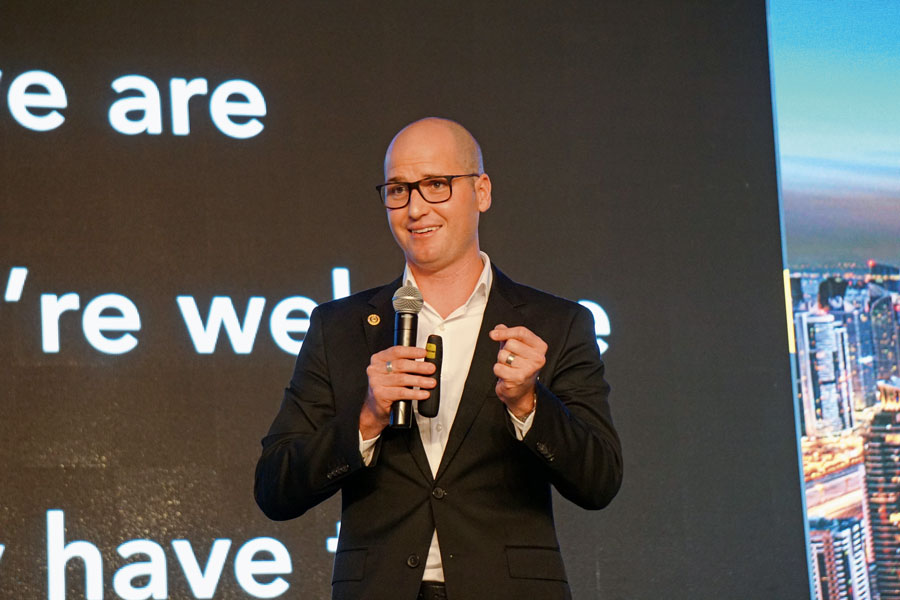
I remember when I started attending Rotary functions years ago as a speaker, at one meet, at the dinner table the conversation turned to heart bypass operations. And everybody shared information on where they had done the surgery, the drugs they were on and the side effects. As a 28-year-old,
I couldn’t contribute much to that conversation! They didn’t mean to make me unwelcome but I did feel out of place!”
How many taxi drivers were looking for an app called Uber that might put them out of business? Very few.
With such anecdotes, eminent social researcher, writer and public speaker, and now a Rotarian, Michael McQueen regaled the packed hall at the Dazzling Dubai Zone Institute. Speaking on the topic “Keeping Rotary relevant”, he gave a gripping account of famous global brands which had either gone bankrupt because they failed to innovate or use technological opportunities, or who read the writing on the wall and quickly adapted to changing times.
It is often said that GenY, who Rotary needs to attract as members, are a generation who “never volunteer, never get involved and never want to give back”. But a look at the NGO Carry the Future shows this is not true. Started in September 2015 by Cristal Logothetis, a young woman in California who was so moved by a TV footage of the plight of refugee children in Syria, that she said we have to do something about it. One of the biggest challenges was that the refugees or migrant families had no proper way to carry their children. “So she got a simple idea, put up a Facebook page to gather funds with the appeal that second-hand carriers may be sent to refugee families. Within a month she had collected $40,000 and over 3,000 used baby carriers to be sent to refugee families in Syria.” Within 3 months she had raised $50,000 and had 5,200 active volunteers. All online and through social media.
At one Rotary club everybody shared information on where they had done the bypass surgery or the drugs and their side effects. At that point, as a 28-year-old, I couldn’t contribute much to that conversation!
While one lesson Rotary could learn from this was that many organisations operate in different ways thanks to technology, the other interesting lesson was that the vast majority of its volunteers “are part of a generation that we are told don’t volunteer, don’t give back, don’t get involved. A generation called the Millennials or Gen Y. I am part of Gen Y myself.” This is the age group 17-35 and a powerful demographic in India with about 35-44 per cent of the population being in this group. “This is a huge group and the absolute key to our future membership,” McQueen said.
Urging Rotarians not to believe the hype that this group doesn’t get involved, he added, “They are involved in many charities such as Carry the Future; they have just not joined our cause.” India has a better than the global statistic of 15 per cent of its membership coming from those under 40, compared to the general Rotary world where only 6 per cent of Rotarians were below 40.
One of the several reasons why youngsters were not joining Rotary, McQueen said, was that “they don’t know about us”. Once, while raising funds at a shopping centre in the US, somebody asked them what the funds were meant for; “I said Rotary, and he said, genuinely, what is Rotary. He didn’t have a clue. Even those who have heard of Rotary don’t really understand what we are about. In a nutshell, we are not good enough at telling our own stories. We do good and we are ashamed to share it.”
Most young people who knew anything at all of Rotary had a “warped view. Perhaps they see it as an exclusive club for retired people, and in many cases, retired men,” he said, amidst thunderous applause.
Dig a well before you get thirsty; reinvent before change forces you to. You can’t wait for change to arrive. It’s too late by then.
The challenge was how to change that perception. Often, the young did not join Rotary because “they don’t know they are welcome in our clubs.” Another key reason was lack of time. “This is a generation that is really busy,” McQueen said, and recalled that when he joined a Rotary club in Sydney, one of his first experiences was introduction to a Rotarian who had been in Rotary for 27 years and “the second thing I was told was he had 100 per cent attendance! That was meant to inspire me but it didn’t; at best it intimidated me because I’ve caught 12 flights in the last 2 weeks. That’s what I do and I’m very rarely around, and many young people have similar schedules. So my first thought was that if that is what is required, then I can’t be a part of it.” Luckily the President told him he was aware how busy McQueen was and added, “Come as often as you can and give what you can.”
So, to attract young people how should Rotary clubs position themselves to the young?
The answer lay in some of the brands which were around for two centuries; those businesses had survived and even prospered because they had done things differently and innovated.
Challenging the audience to remember something they were taught in high school, McQueen said he too had forgotten the principle of entropy taught in Physics — that matter left to itself will decay and disintegrate. “I never realised that one day I would dedicate a chunk of my career to entropy and how it applies to businesses, organisations and institutions that I’ve been tracking for 14 or 15 years.”
Lego had thought innovatively, making use of technology to stay relevant, profitable and more powerful than ever before, and pulled back from the verge of bankruptcy in 2004.
In 2011 we saw many iconic brands fall prey to entropy; massive businesses going into bankruptcy and the biggest of them all was Kodak. The questions here were why do the mighty fall? How did they go from a position of strength, growth and prosperity, to losing that edge and becoming obsolete, irrelevant and in some cases, completely bankrupt?
The second question that has driven his research, and is far more important, is why do some organisations allow the injury to prevail, whereas others — business and non-profit — keep growing and remain relevant for long periods… decades, centuries. The answers have been recorded in his book Winning the battle of Relevance, “where I have looked at Rotary consistently asking how do these questions apply to us as an organisation.”
The one word which describes why even the mightiest of businesses lose their edge, and fail is disruption. “This word describes change that wasn’t expected. How many taxi drivers were looking for an app called Uber that might put them out of business? Very few. How many hotels had any idea that Airbnb might take a huge chunk of their business? That is disruption. When you aren’t expecting or looking for it, it can come overnight and change the game totally.”
And technology plays a huge role in disrupting established businesses. McQueen showed slides of how in the last 10 years, brand repositioning has happened. In 2006, the five biggest companies in the world by market capitalisation were Exxon, GE, Total, Microsoft, and Citi with respective market cap of $446, $383, $327, $293 and $273 billion. Two of these were energy companies, one bank and an IT company.
By 2011 Exxon still led ($406 billion) and Apple had come from nowhere to be in the second position with $376 billion. There were three energy companies; it was a good time to be in oil. And a Chinese bank came from nowhere to the fifth position, “at a time when American banks were holding on for dear life!”
In the chart published, technology companies are colour coded in green. Come to 2016 and all the five big companies in the world are in technology and all of them have “largely got there by disrupting other businesses and other industries. Apple is leading ($582 billion); followed by Alphabet ($556), Microsoft ($452), Amazon ($364) and Facebook ($359).
Next, said McQueen, let us look at the disruptions in the future. The use of nano technology in robotics and the 3D printing world is gigantic. Autonomous vehicles are also on the anvil, he said, and asked, “How many of you find the idea of a driverless car terrifying? These are much closer to becoming a reality than we think. Recently, Ford announced that by 2021 they will roll out the first car off their production line that has no steering wheel!”
Introduction to a Rotarian with 100 per cent attendance was meant to inspire me but it didn’t; it intimidated me because I’ve caught 12 flights in the last 2 weeks. That’s what I do and I’m very rarely around.
What intrigues a business analyst is how it is going to impact businesses and industries and those will be many. “There are many industries right now who have no idea of what is going to hit them. One industry is the auto insurance industry and the smart ones are nervous about this. They won’t tell you, but I can, because many of them are my clients and behind closed doors they are scrambling to get ready for this. Think about this: if you have an accident in a driverless car, who is at fault? Because insurance is liable to pay. The whole base of that industry is that the person at the helm of the car is in control of that vehicle.”
Other industries which will be dramatically impacted by this will be the flight and logistics businesses; and truck drivers will be an endangered species within three decades. And then there is the Paid Parking industry. “I was having lunch with a guy who has a 50 per cent stake in one of the big paid parking companies in Australia. An extraordinary, successful, wealthy man, he knows what is coming. His question over lunch was: when do you think I should sell my shares?”
Think of a future when there might be a fleet of millions of driverless taxis. “The next question will be why would you even own a car in the first place? I was looking at my 30-month-old
son recently and thinking there is every chance he would never get a driver’s licence. And if it is not him, it will be his kids!”
Rotary as an organisation was also not immune to disruption; we are part of a global community. We engage with many communities but how we build communities or engage with them has changed enormously. Because of technological disruption in the last 10 years.
McQueen said he and RI Director Manoj Desai were part of RI’s Strategic Plan committee which looks at Rotary’s future. “But rather than look at technology as a threat, and many of us do that, can I suggest it can be a phenomenal opportunity to leverage and enlarge our influence to re-engage people who are disengaged and have left or attract people who might otherwise have never joined our organisation.”
Some of the thoughts he left the Rotarians with include:
- Dig a well before you get thirsty; reinvent before change forces you to. You can’t wait for change to arrive. It’s too late by then, because you are in survival mode and not operating in a strategic mode. The great challenge for you in the districts in India is that you are growing. But often with growth and success comes complacency and that is incredibly dangerous.
- Earlier, the definition of insanity was: Doing the same thing over and over again and expecting a different result. Today, it is the opposite.
- Avoid the trap of auto pilot and engage with people and ideas all the time.
- India has a better than the global statistic of 15 per cent of its membership coming from those under 40, compared to the general Rotary world where only 6 per cent of Rotarians are below 40.
- Leverage fresh eyes. Think outside the box. People with fresh eyes seek simple solutions to problems.
Pictures by K Vishwanathan
Lego’s success story
Michael McQueen, who keeps a firm eye on emerging trends, said several businesses had gone bankrupt because of disruptive technologies and one big example was Kodak. But a brand like toy maker Lego had reinvented itself and thought innovatively, making use of technology to stay relevant, profitable and more powerful than ever before. “A few years ago, Lego was the most powerful brand. They beat McDonalds, they beat Coke, they beat Apple.” But in 2004, Lego, according to some reports, was “seven months away from bankruptcy. They were in serious trouble for a number of reasons, one of them being that disruption had occurred for Lego as a brand. Throughout the 1990s, suddenly all the cool kids didn’t want to play with plastic blocks anymore because video game had come on the scene.”
Adhering to the strategy if you can’t beat them, join them, Lego came out with its own range of video games, and developed a gaming system called the Lego Universe, created a smart phone app, etc. While using a lot of technology in this, it also kept reinventing its toy range. “The smartest thing they did a few years ago was realising that there was group of consumers they weren’t resonating with — girls — which is one half of the population, it came out with the Lego friends’ toys range and within two years, 27 per cent of its global revenue came from toys sold to girls!”







